
Tate St Ives
27 May 2023 – 14 January 2024
by DAVID TRIGG
The trend for brightly coloured, hard-edged geometric painting that swept through the Casablanca Art School (CAS) in the late 1960s would have shocked the institution’s founders. Established as the École Municipale des Beaux-Arts de Casablanca in 1919, the school was still shaking off its roots in French-colonial ideology when the young Moroccan artist Farid Belkahia (1934-2014) became its director in 1962, six years after Morocco gained independence from France and Spain. Building on the programme of modernisation initiated by his predecessor, Maurice Arama, he assembled a radical faculty who rejected academic easel painting and orientalist figuration, embracing instead the interdisciplinary approach of the Bauhaus. Together, they reimagined the relationship between post-painterly abstraction and traditional Moroccan arts and crafts to create a local modernism that was nothing less than an artistic revolution.
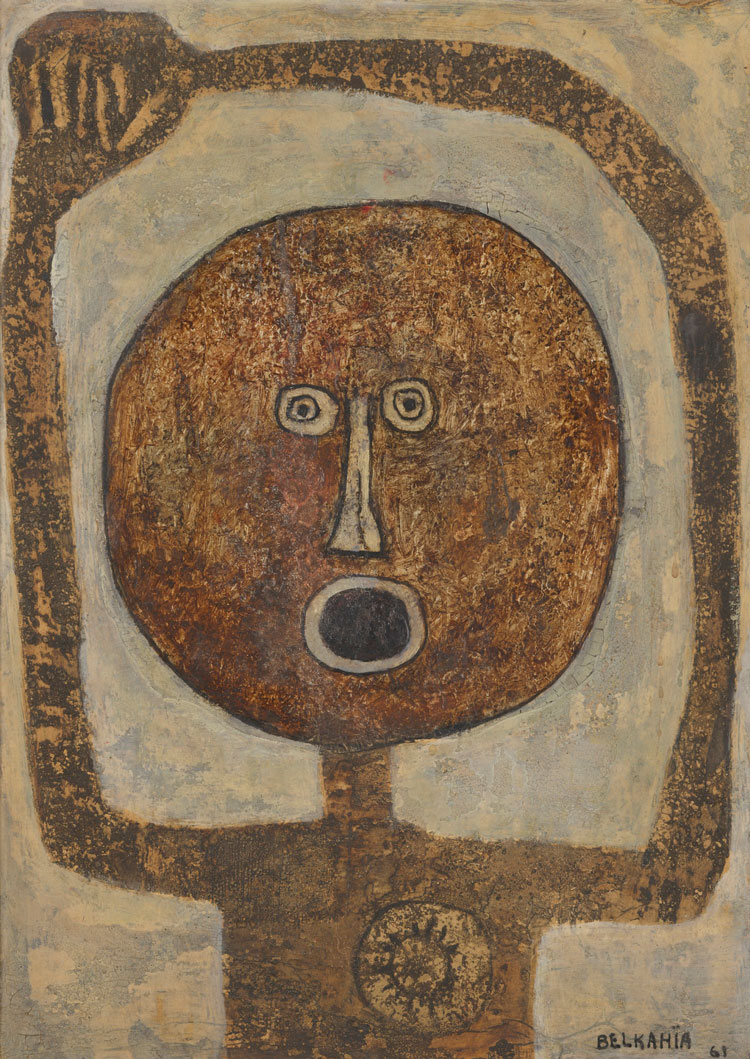
Farid Belkahia, Cuba Si, 1961. © Foundation Farid Belkahia. Tate Purchased with funds provided by the Middle East North Africa Acquisitions Committee 2016.
Belkahia’s early oil paintings responding to colonial regimes and international conflicts are among the handful of figurative works in this ambitious survey at Tate St Ives, the first museum exhibition dedicated to the CAS. The angry figure with its hands raised in his Cuba Si (1961) refers to the Bay of Pigs invasion of Cuba, while the limp, emaciated figure hanging upside down by one leg in Tortures (1961-62), expresses the artist’s outrage at French atrocities in the Algerian war of independence.
In 1964, Belkahia appointed Mohamed Melehi (1936-2020) as a painting tutor at CAS. He had been living and working in America, an experience that inspired the hard-edged, Barnett Newman-inflected canvas Minneapolis (1963), in which a horizontal sliver of grey and yellow divides a black rectangle from a larger expanse of red beneath it. Later, he embraced curved wave forms and vivid, luminous colours. When he arrived at CAS, he found “a rich and intense hub of artists”, who were “animated by the ambition to modernise and rethink the role of the artist in society”.1
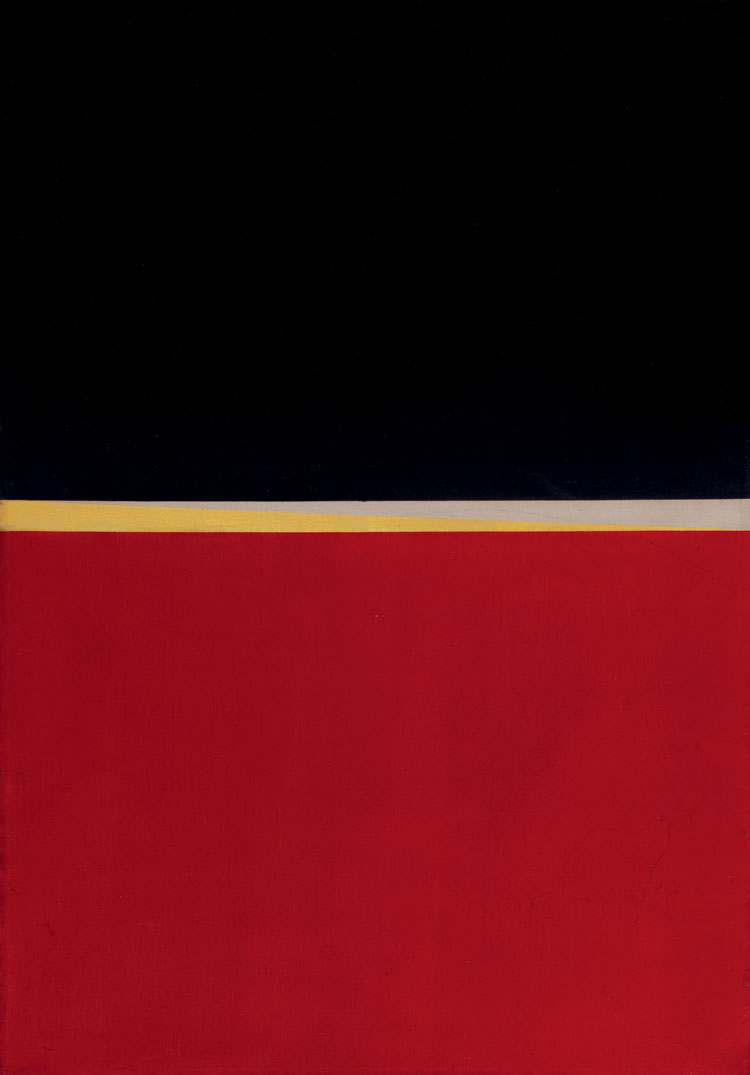
Mohamed Melehi, Minneapolis 1963. © Mohamed Melehi Estate. Courtesy of private collection, Marrakesh.
Melehi’s belief that art in Morocco was ready for transformation was shared by Belkahia as well as Mohammed Chabâa (1935-2013), who had been hired to teach graphic design at the school. The three artists, known informally as the Casablanca Trio, held their first joint exhibition in Rabat in 1966, presenting their work in the hall of the Mohammed V Theatre. By using this semi-public space, they declared their opposition to the state-organised “salon” exhibitions, which were notorious for sidelining and undermining the agency of Moroccan artists.
In 1969, they protested the French-founded Salon du Printemps (Spring Fair exhibition), which categorised Moroccan artists as “naive”. Joining with Mohamed Ataallah, Mustapha Hafid and Mohamed Hamidi, they organised the outdoor exhibition Présence Plastique, bringing their art directly on to the streets.
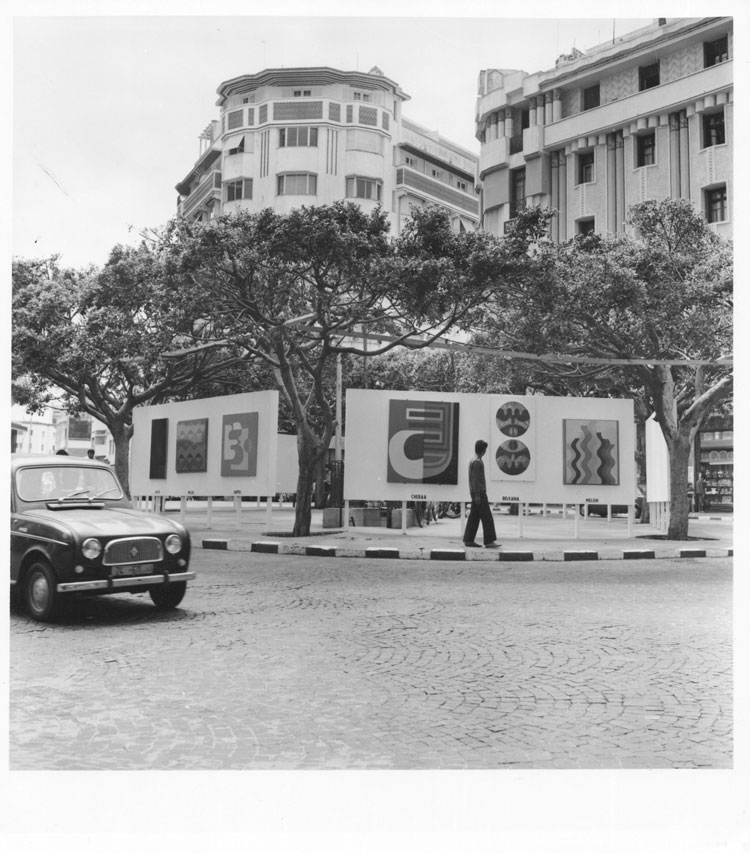
View of Plastic Presence manifesto exhibition, 16 November Square, Casablanca, June 1969. Photo: M. Melehi. © M. Melehi archives/estate.
Installing their dazzling abstract paintings and colourful murals in the public squares of Marrakech, they engaged people from all walks of life and every social class away from the rarefied environment of galleries and salons. As those associated with CAS increasingly reconsidered the social function of artists, such anti-elitist gestures became defining moments in the history of postcolonial Moroccan art and are now considered landmarks of modernist activity in the global south.
CAS staff members such as anthropologist Bert Flint encouraged a re-engagement with the traditional arts of Morocco. He researched in the High Atlas and Anti-Atlas mountains of Morocco, led classes on Arab, Amazigh, Islamic and Mediterranean heritage. Melehi was adamant that abstraction was not foreign to Morocco, but was, in fact, the true expression of north African art, being found in craft traditions that dated back centuries. In St Ives, a display of his photographs of Amazigh jewellery is exhibited alongside a large Amazigh rug and a carved wooden pillar, all of which feature geometric patterns and motifs that are echoed throughout the show, in paintings, drawings, prints, murals, posters, book covers and even interior design. Yet, with no attempt to contextualise these objects by explaining the original spiritual and social factors that led to their creation, we are left wondering what significance they had for Flint, Melehi and their students beyond an engagement with their formal qualities.
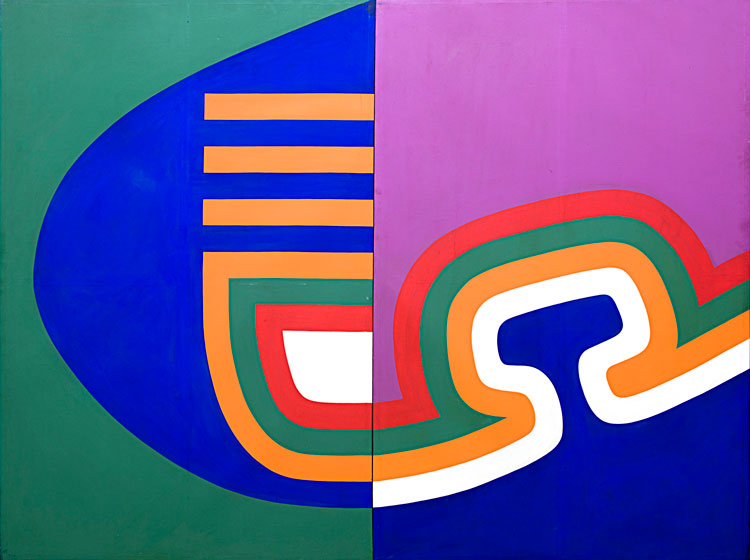
Mohammed Chabâa, Composition, 1975, Acrylic paint on media, 152 x 202 cm. Société Générale Maroc. © Chabâa Foundation.
In addition to bringing artworks on to the streets, CAS artists experimented with strikingly modern and dynamic graphic design to connect their work with public life. Chabâa was integral to this, teaching decoration, scenography and typography classes, and working with Melehi to co-design book covers, posters and logos that reflected their political commitments and support for Angolan and Palestinian resistance movements. They also designed the leftwing cultural journal Souffles, 16 issues of which are displayed here. Between 1966 and 1972, the journal aspired to decolonise and democratise Moroccan arts and culture until it was banned during the rule of King Hassan II, the “Years of Lead”, which were marked by the repression of political dissidents and activists. Chabâa himself was imprisoned for Marxist activism, as was the founder of Souffles, the poet Abdellatif Laâbi. This important part of the CAS story is, however, only briefly addressed.
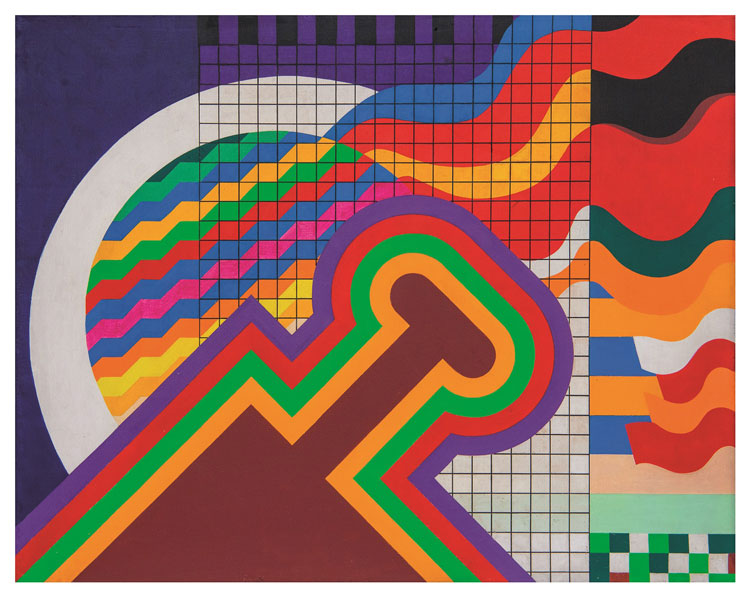
Mohammed Chabâa, Untitled, 1977. Acrylic on canvas. Tate collection. Photo: Fouad Mazouz.
Belkahia left the CAS in 1974, the year of the first pan-Arab Biennial at Baghdad’s Museum of Modern Art in Iraq. He curated the exhibition’s Moroccan delegation, which included 14 artists associated with the school. Their bold and vivid works pointed to the country as the centre of a dynamic new wave in Arab art, so much so that CAS artists were invited to organise the second edition of the biennial in Rabat in 1977, which further spread their vision. In a room of works from this period, Chabâa’s complex configuration of angled lines, uniform grids and undulating waves in Untitled (1977) contrast with Melehi’s elegantly minimal Flamme (1976).
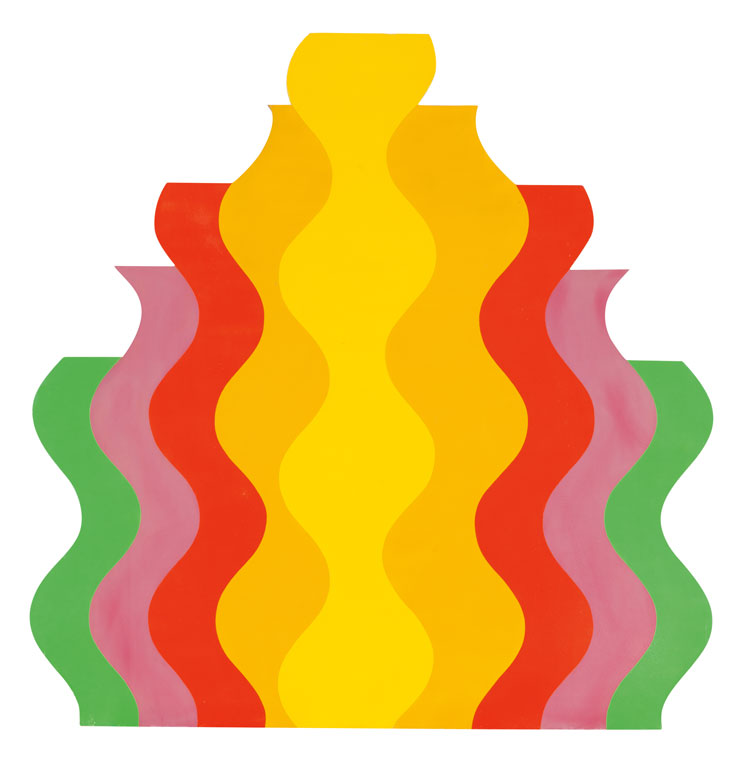
Mohamed Melehi, Flamme, 1976. Private collection.
The influence of both artists is seen in Abdelkrim Ghattas’ colourful Composition (1977), in which a horizontal band of busy interlocking geometric shapes is balanced with vertical stripes and a green monochrome background.
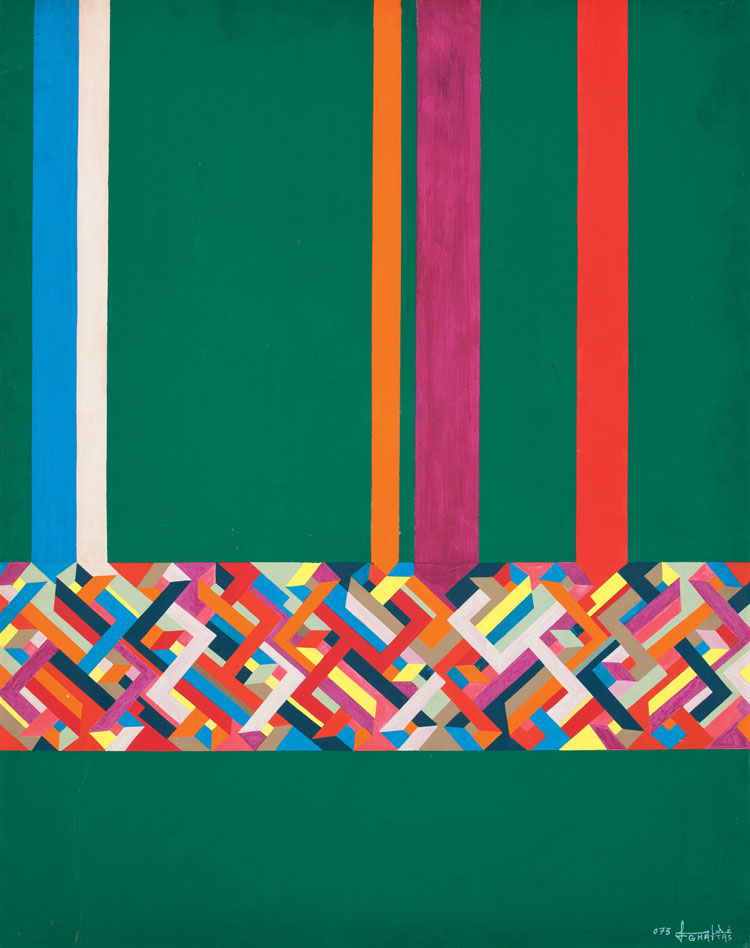
Abdelkrim Ghattas, Composition, 1977. Private collection.
In 1978, Melehi and Mohamed Benaïssa co-founded the Asilah Festival, which continued the Casablanca artists’ democratising mission by bringing contemporary art directly to the community through street exhibitions and murals. The annual festival gave a platform to numerous artists, including those overlooked by the mainstream such as the self-taught painter Chaïbia Talal. She was once dismissed as a “naive” artist and her large, exuberant La Cérémonie du Mariage (1983) closes the show with its colourful evocation of a jubilant wedding party. It is another example of how those associated with the CAS challenged and reimagined what modern art in postcolonial Morocco could be – a legacy whose impact endures to this day.
Reference
1. Mohamed Melehi in conversation with Morad Montazami, Third Text, 12 February 2021.
Giuseppe Penone: Thoughts in the Roots
With numerous works created with the twigs, leaves, roots, branches and majestic forms of trees, thi...
Solange Pessoa: Pilgrim Fields
An olfactory orgy of marigolds, chamomile, grasses, sheepskins and kelp is arranged into a surreal l...
Christian Krohg: The People of the North
A key figure in Norwegian art, naturalist painter Christian Krohg wanted his art to bring social cha...
This comprehensive show charts the groundbreaking rise of the illustrated poster in 19th-century Fra...
Caspar David Friedrich: The Soul of Nature
This comprehensive show celebrating last year’s 250th anniversary of the Romantic painter’s birt...
A humongous survey of contemporary painting in Belgium shows a medium embracing the burden of its hi...
A retrospective of the first 20 years of the Max Mara Art Prize for Women finds an inexhaustible wel...
This new work is very much about indeterminate selfhood as Nora Turato immerses the visitor in a swi...
Burmese artist Htein Lin has been jailed many times and this show includes some of the remarkable pa...
This retrospective brings the acclaimed and trailblazing, but nearly forgotten French modernist arti...
Mainie Jellett and Evie Hone: The Art of Friendship
A kaleidoscope of colour through which the history of modernism is refracted, this exhibition brings...
In this major retrospective, the viewer is like an avatar navigating the humans – real and CGI –...
Sharjah March Meeting 2025: To Carry Songs
Sharjah Art Foundation’s annual symposium this year explored how culture is preserved and shared w...
Christopher Le Brun & Charlotte Verity – interview: ‘There is such a t...
To coincide with a rare joint exhibition now on view at The Gallery at Windsor in Florida, Christoph...
Valentina Karga highlights the ecological horrors ravaging our world, but her aim is not to shock or...
Peter Mitchell: Nothing Lasts Forever
Peter Mitchell’s photographs of urban decay and the demolition of buildings in Leeds over the past...
Lee’s headless heroines and canines are the fifth of the Met’s Genesis Facade Commissions. But w...
Lina Lapelytė – interview: ‘Between this group of performers, what we...
Perhaps best known for her eco-opera Sun & Sea (Marina), Lina Lapelytė discusses her approach to im...
Spanning four centuries and diverse cultures, this show of more than 7o works, including paintings, ...
With highlights from the Courtauld’s collection of German and Austrian modernist works on paper an...
Louise Bourgeois, Sheida Soleimani and Gillian Wearing are among the 30 female artists contributing ...
In this mind-blowing and dazzling exhibition, Rafał Zajko takes us into a mysterious realm of art a...
Mahtab Hussain: What Did You Want to See?
With portraits of mosques and people at prayer, British Asian photographer Mahtab Hussain documents ...
The Cosmos of “Der Blaue Reiter” – From Kandinsky to Campendonk
This show retraces the roots of the expressionist artists who made up the Blue Rider group, looking ...
Celia Paul: Colony of Ghosts* and Celia Paul: Diaries**
Two concurrent solo exhibitions paint a much broader portrait of the artist Celia Paul, debunking th...
Edvard Munch’s portraits have flown under the radar, but getting to know his sitters reveals a lot...
In her films, sculptures, tapestries and prints Yto Barrada plays with the materiality of colour...
Delaine Le Bas – interview: ‘People still have expectations about what...
From the heart of her installation at the White House in east London, Romany artist Delaine Le Bas t...
Olivia Bax – interview: ‘With art, there are so many unwritten rules a...
Sculptor Olivia Bax talks about curating These Mad Hybrids: John Hoyland and Contemporary Sculpture,...
Astonishing Things: The Drawings of Victor Hugo
The Royal Academy of Art’s new exhibition reveals the mighty French novelist as a fascinating, eve...